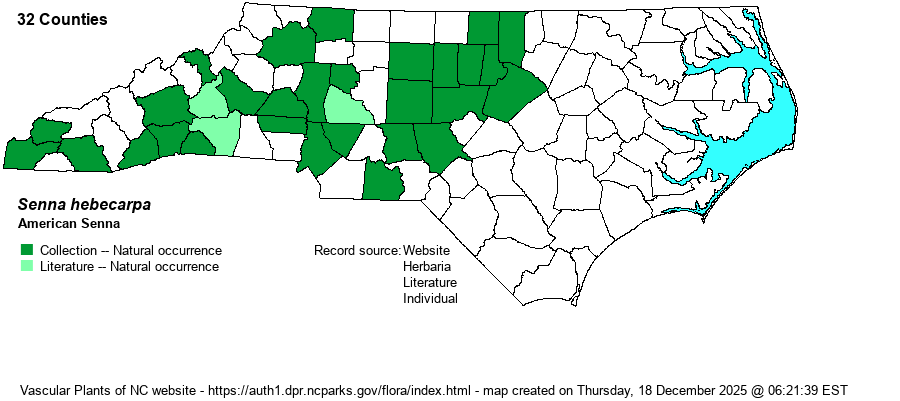| Habitat | This is a species of moist to damp habitats, and it favors openings in bottomlands, creek banks, wet thickets, and edges of moist or rich forests -- typically in partial sun. Whether there is an affinity to circumneutral soils in the state is not certain, but it does not show a tendency toward "weediness" that S. marilandica often does. | |
| Identification | This is one of two native species in the genus Senna that were formerly in the genus Cassia, with some other obviously different species. This is a fairly tall and robust species, growing erectly and to about 3 feet tall, rarely to 5 feet tall. Though essentially unbranched, it has very long leaves that make the plant appear branched and bushy. The leaves can be 10-12 inches long, and they are highly divided into 10-20 fairly large leaflets. Each leaflet is roughly elliptic and about 1.5 inches long and about 0.5-inch wide, thus about 1/3rd as wide as long. (S. marilandica is essentially identical in these features.) In this species, there is a small somewhat club-shaped gland in the leaf axils, and this gland has a slightly narrow stalk (barely visible); in S. marilandica, these glands are rounded and essentially sessile. However, this is a very tricky field mark, in that the stalk is hard to see, and it is easy to call a Senna species as S. marilandica by this character when in reality it may be S. hebecarpa. The inflorescences of both species are also extremely similar; each has showy clusters of racemes in axils and at the summit of the stem. These flowers are quite large, bright golden-yellow and about 1 inch across. (There might be slight differences in the flowers or pattern of inflorescences, but these are not mentioned in various keys.) To be certain, you must have the pods present, and it is better to have some familiarity with one or the other species to feel comfortable. The pods of S. hebecarpa differ in three ways: 1) they are quite narrow, from 5-8 mm wide (about 1/4-inch), as opposed to 8-11 mm wide (about 2/5-inch) in S. marilandica; 2) it is quite hairy overall (especially at first), as opposed to mostly glabrous in S. marilandica; and 3) the many segments of the pod are square-shaped (about as long as broad), as opposed to rather narrow (wider than broad) in S. marilandica. It should be mentioned that the shape of the pod segments can be tricky to judge without familiarity with both species, and the hairiness of the pods of S. hebecarpa can depend on fresh or old pods. Also, pods that are rather immature are obviously going to be smaller than when mature, and thus a developing pod of S. marilandica, when measured, may well be less than 8 mm wide. Thankfully, neither species is truly rare in the state, and ranges are somewhat similar, and thus mistaken identity when in the field is not overly critical, other than collecting one for an herbarium and getting the incorrect identification. However, it is quite important in establishing new county records for each. Field biologists often run across a few of these two species annually in their work, such as along greenways while walking in bottomlands, or along wet thicket margins; when in bloom, they are absolutely impossible to overlook. But, you almost certainly should re-visit the site(s) later in summer or fall, and identify the plants by the pods and not by flowers or glands. | |

